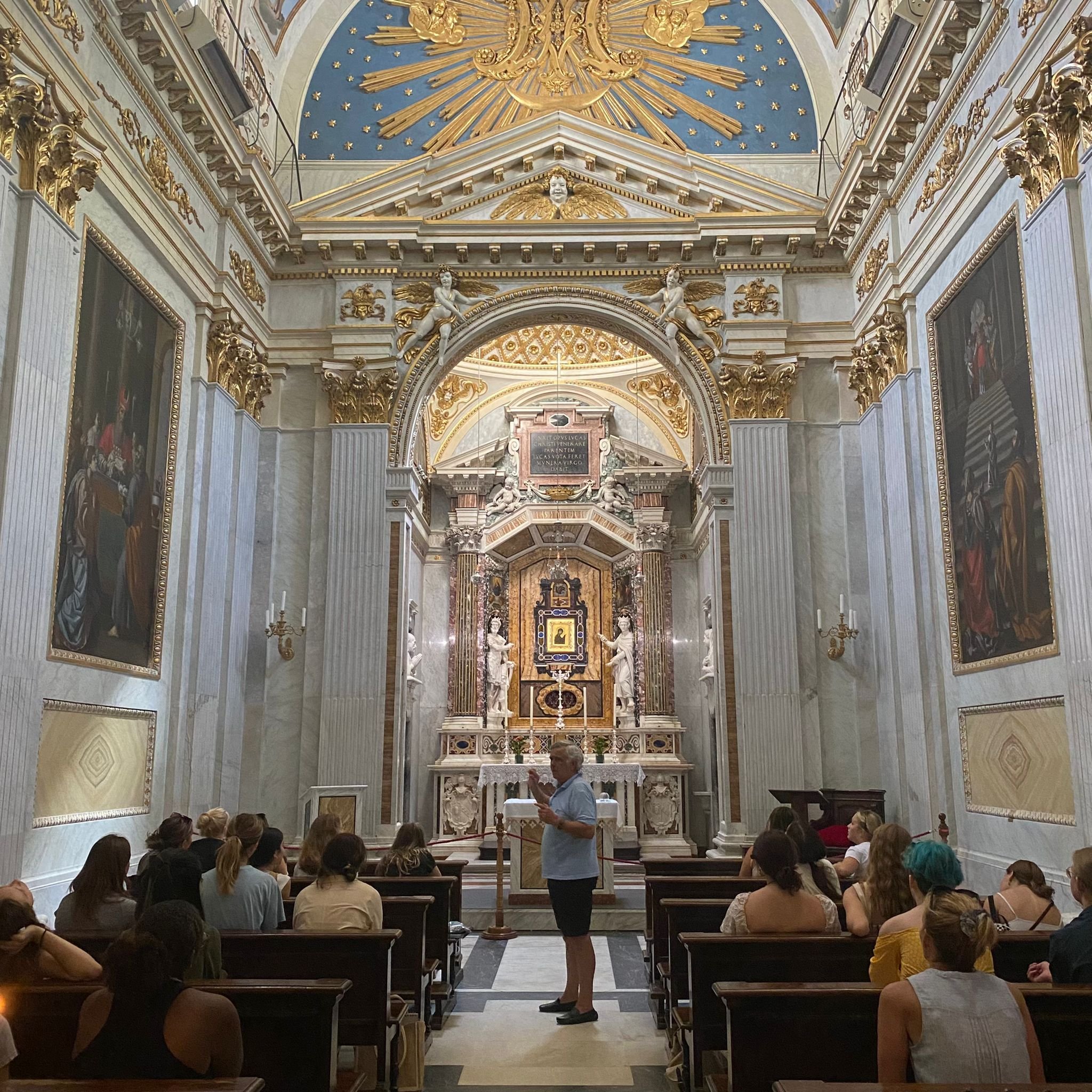Day 7: Touring Spoleto's Duomo
SSA students touring the duomo in Spoleto, led by Lorenzo Muti
Photography and art students began the day together with a tour of the Duomo di Spoleto led by Lorenzo Muti. The duomo was built in the 12th century, although like several other buildings in the area, it was built around an existing building. We learned that the lions, seen in sculptures near the duomo’s entrance, have symbolized the strength of the Catholic Church, and are common at Romanesque churches. The portico was built in the 15th century. It features Renaissance elements such as the harmonious interplay of geometric patterns in the floor tiles, and emblems including the bees symbolizing the importance of the Barberini family (one member being the Bishop of Spoleto, who later became Pope Urban VIII).
The entrance to Spoleto’s duomo, featuring lion sculptures
Upon entering the duomo, strains of soft organ music filled the air. The duomo is known as the Cathedral of Santa Maria Assunta (Cathedral of the Ascension of St. Mary), celebrating Mary’s life and ascent to heaven. This is depicted in a series of frescos by the artist Filippo Lippi entitled Stories of the Virgin (1466–1469). Mr. Muti explained how the artist used sketching and plaster techniques to produce the vivid images–and yet how some areas in which artists used dry-painting techniques on plaster added much later did not stand the test of time.
As an interesting side note, Filippo Lippi is also famous for having been a monk who fell in love with a nun and started a family. His self-portrait appears in the fresco above the choir loft. He is said to have continued to wear his monk robes for the rest of his life.
In the rear of the church sits the Chapel of the Most Holy Icons, home to a Byzantine icon constructed of wood and silk which is believed to have mysterious, supernatural healing powers.
We exited the duomo and headed down a steep staircase along the Roman walls of the city, crossing the Via Flaminia to enter the Monumental City Cemetery, also known as the City of the Dead. According to Roman burial traditions, people were buried along great roads. The cemetery lies on a hill alongside the Via Flaminia, one of Rome’s great roads. It is a place where family members can come to stay in touch with loved ones who have passed, which is reflected in the small stone buildings constructed there, almost like a village of tiny houses. Many of the tombs and gravestones have flowers, living plants, photographs, lights or candles, within a glass enclosure further encased by ornate iron gates.
Spoleto’s “City of the Dead”
At the top of the hill lies the Basilica di San Salvatore (the Basilica of St. Savior) a UNESCO World Heritage site. Thought to have been built between the 4th–5th centuries, it is one of the oldest churches in Europe. It was originally dedicated to Concordio and Senzia, martyrs who were believed to have worked miracles. A group of Syrian monks arrived in Spoleto from Monteluco and started living in the caves nearby. They brought with them architectural styles from the east which are reflected in the design of the church’s ambulatories. Although it is currently closed for repairs due to damage from the earthquake in 2016, peering in the window at the front of the church one can get a sense of the air of mystery this special basilica holds.
Mid-morning the visual arts students returned to the studio to continue the previous day’s projects of their choice, some listening to music on headphones, while others worked to the soundtrack of Mamma Mia! Media included charcoal, lead pencils, kneadable erasers, conté, watercolor, acrylic paint, oil pastels, and chalk pastels.
Photography students have been writing reflections on their work for presentation. They are planning how to use their time over the next couple days as they wrap up their projects.











